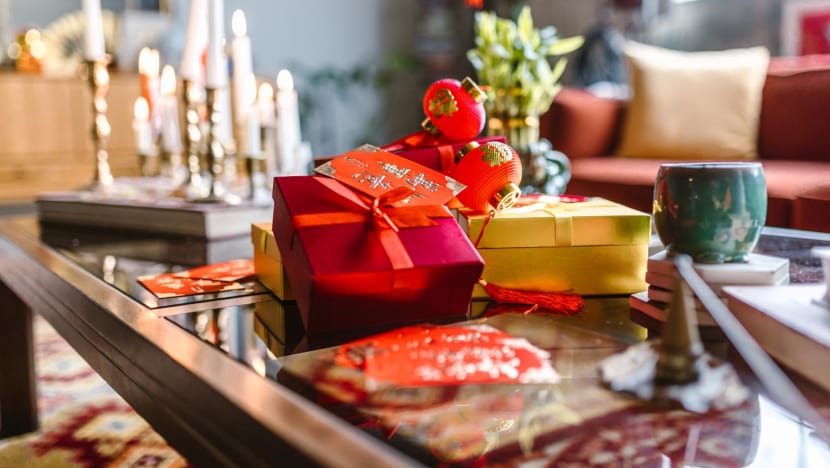From feasting to spring-cleaning: How to have a sustainable Christmas and Chinese New Year
Plan ahead for an eco-friendly festive season by catering smart and picking the right hongbao.

File photo of gift boxes and red packets. (Photo: Pexels)
SINGAPORE: It is that time of the year again – the month-long spell from Christmas to Chinese New Year gleams with the promise of indulgent parties and time-honoured family traditions.
As you prepare to celebrate with glistening meats and plastic ornaments, your guilty conscience may be triggered by the thought that, maybe, this is not the best way to celebrate another year on a warming Earth.
To lower your waste output, follow the old adage of reduce, reuse and recycle – but remember to do so in that order.
Use only what you need, and then reuse them for the same or a new purpose. If anything is not needed, sort it into recycling bins. Here is how you can apply this to your festive plans.
SERVE LESS FOOD THAN YOU THINK
It is usually safe to cater for 10 per cent to 15 per cent fewer guests than the number who are attending, according to the National Environment Agency (NEA).
If you do need to serve food in large quantities, portion before serving so that any leftovers are kept clean for storage.
You can also proactively plan to use leftovers. Take home the carcass of the roast chicken and make chicken stock – this reporter has done that.
Food waste is one of the biggest waste streams in Singapore, with 817,000 tonnes generated last year, so every grain of rice saved from the bin counts.
Ms Stephanie Dickson, founder of Green is the New Black, a platform that promotes sustainable living, said food waste also goes up “massively” over the year-end festive period quoting a study done in Australia.
The study by Melbourne University found that food waste in December and January goes up by 40 per cent because more people eat out and celebrate.
“(It) is really quite shocking,” she told CNA podcast The Climate Conversations.
EATING LESS MEAT
There are also ways to make Christmas parties more sustainable, Ms Dickson said.
She gave examples of including more plant-based food options and using crockery and cutlery already available at home instead of buying disposable ones.
“I don't think there's any need to have single-use items when you have everything in your house. If you don't have enough to cater for everyone, ask them to bring their own plate and cutlery,” she said, adding that this is a practice at many events nowadays.
Getting people to bring their own containers and getting them to pack excess food home also doubles up as a way to avoid food waste, she said.
She added that those who over-cater can consider giving excess food away to others in the neighbourhood or donating to food charities.
CONSCIOUS GIFTING
Christmas does not have to revolve around consumption and physical gifts, said Ms Dickson.
“We can start to get a little bit more creative about how we gift to our family and friends,” she said, adding that people can start to take the materialism out of giving gifts and look at shared experiences instead.
“You can have many different types of experiences or go on holiday. There are things like subscriptions to different things that you could have,” she said, citing the example of publications.
Edible gifts can also be enjoyed together, she added.
She said that for those who are already on their sustainability journey, the holiday season can also be used as an opportunity to educate loved ones by helping them understand the use of zero-waste products.
It can also be an educational journey for older children, she said. They can be encouraged to volunteer with a charity or donate their toys to children in need.
“Trying to create different traditions through experiences at Christmas time can be something really beautiful and can set the kids and the family on a completely different trajectory for what tradition looks like at this time of year,” she said.
MORE LOVE FOR PRE-LOVED
Gifts can also be pre-loved, Ms Dickson said, adding that the taboo around gifting pre-loved items needs to go.
“There's so much good stuff in the secondary markets and you can get some really great deals, very high quality items,” she said.
Re-gifting should also be more accepted, she added.
“Sometimes, you might receive gifts, and they may not be right for you. But they might be right for someone in your life. I think it's a beautiful thing to be able to repurpose, and to give that to someone else," she said.
The same applies to gifts for children, said Ms Dickson. She added that toy swaps are options when it comes to getting presents for them.
“Especially when the kids are young, they're not going to know something's brand new or not. And sometimes they don't even really care about the gifts, sometimes they like the box more.”
DITCHING WRAPPING PAPER, REUSING TREES
There is not really any need to buy wrapping paper these days, given that many people have packaging from items delivered to their homes, said Ms Dickson.
“You could just upcycle some of what gets delivered to your house, like keep some of that packaging, especially if it's nice,” she said.
Items like paper boxes can be jazzed up with a little painting and even old clothes can be used to wrap gifts.
Ms Dickson said that she once used newspapers to wrap her Christmas gifts. “It doesn't need to be sparkling, shiny, new wrapping paper that also sometimes can be difficult to recycle. Using what you have, collecting the packaging that's already been brought to your house, and then just sort of repurposing – that is a great place to start."
If every American family wrapped three presents in reused materials a year, they would save enough paper to cover 45,000 football fields, she said.
“And that's just America. You can't imagine how we (can) expand that to the rest of the world as well.”
Ms Dickson also urged families not to buy a fresh Christmas tree every year.
“If we were to buy a fresh tree every year, that means that tree has come from somewhere around the world, it's been shipped in cold storage, and it's got to us fresh, and then it lasts for maybe two, three weeks, and then it dies.”
Buying a reusable tree that can last for years or second-hand trees are better options. Reusing Christmas decorations is also a good idea, she added.
While going treeless may be the most eco-friendly option, she acknowledged that traditions run strong.
“We don’t want people to feel like they are sacrificing. We want people to feel like they are going on a slightly different adventure or doing things in a different way,” she said.
SPRING-CLEAN RESPONSIBLY
Every year, spring cleaners leave lorryloads of unwanted belongings at Salvation Army donation drop-off points. Last year this overwhelmed the organisation, which had to close some points temporarily.
Before donating anything, ensure that the items you want to give away are in good working condition. Then consider spreading the cheer around by giving to other organisations and specialist second-hand shops.
Volunteer-run Recyclopedia is a comprehensive resource with a directory of places that will take in used goods. It includes details such as the condition that the items should be in and whether drop-offs are allowed.
The website also has recommendations on how to recycle or responsibly dispose of specific items, such as landline phones, jigsaw puzzles and school uniforms.
If you want to be sure your items are going to someone who will take care of them, you can take a targeted approach with a listing on a “freecycling” app like Olio, where people give away unwanted items.
RETHINK “NEW” CLOTHES
Wearing new clothes at Chinese New Year is supposed to symbolise a fresh start and herald good fortune for the year ahead.
But in a day and age when most of us are flush with disposable income and buy new clothes multiple times a year, it is perhaps timely to consider whether this tradition still serves you.
If it is a question of style or simply wearing something your friends and family haven’t seen before, then there is no lack of options in vintage boutiques or clothes swaps around Singapore.
Reducing or re-wearing clothes is all the more important because textile waste had the lowest recycling rate of 4 per cent out of 189,000 tonnes generated in Singapore last year.
USED NOTES ARE STILL MONEY
During Chinese New Year, the love for all things new extends to the banknotes in your red packet, but that crisp note comes at a price to the environment.
Issuing new notes generates carbon emissions comparable to powering 430 four-room Housing Board (HDB) flats. About 10,000 new trees need to be planted to offset the emissions.
The Monetary Authority of Singapore (MAS) is encouraging the use of “fit-for-gifting” notes instead. These are used but clean bills that have been verified by banknote processing machines, and are similar in quality to notes from automated teller machines (ATMs).
They are a more sustainable option compared to new and “good-as-new” notes. MAS will also stop issuing good-as-new S$2 notes from the upcoming Chinese New Year.
More details on reserving and exchanging fit-for-gifting notes, or new ones, will be available towards the end of the year.
Just remember, a used S$2 note is still worth S$2.
PICK THE RIGHT HONGBAO
Authorities have encouraged the use of e-hongbao for years. But for many, the act of giving a red packet and receiving good wishes and two mandarin oranges in return remains a cherished interaction across generations.
If you prefer to give a physical hongbao, go for paper ones that are not printed with huge amounts of red ink, gold ink or glitter, as those are harder to recycle, a paper recycling firm told CNA previously.
To extend the shelf life of your red packets, buy those with evergreen designs instead of zodiac-specific motifs – that way you won’t have to throw them out or wait a dozen years to use them again.
Closer to Chinese New Year, look out for the dedicated red packet recycling boxes at local banks. Those at DBS/POSB branches are available year-round.























